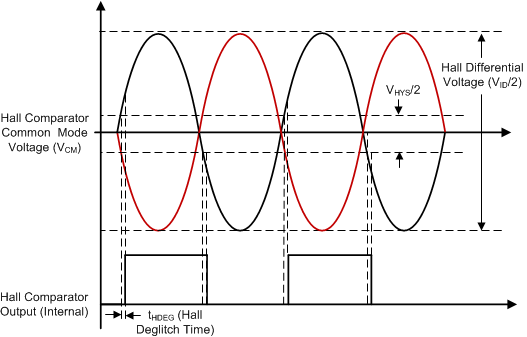SLVSE38A April 2018 – July 2018 DRV8306
PRODUCTION DATA.
- 1 Features
- 2 Applications
- 3 Description
- 4 Revision History
- 5 Pin Configuration and Functions
- 6 Specifications
-
7 Detailed Description
- 7.1 Overview
- 7.2 Functional Block Diagram
- 7.3
Feature Description
- 7.3.1 Three Phase Smart Gate Drivers
- 7.3.2 DVDD Linear Voltage Regulator
- 7.3.3 Pulse-by-Pulse Current Limit
- 7.3.4 Hall Comparators
- 7.3.5 FGOUT Signal
- 7.3.6 Pin Diagrams
- 7.3.7 Gate-Driver Protective Circuits
- 7.4 Device Functional Modes
- 8 Application and Implementation
- 9 Power Supply Recommendations
- 10Layout
- 11Device and Documentation Support
- 12Mechanical, Packaging, and Orderable Information
Package Options
Mechanical Data (Package|Pins)
- RSM|32
Thermal pad, mechanical data (Package|Pins)
- RSM|32
Orderable Information
7.3.4 Hall Comparators
Three comparators are provided to process the raw signals from the Hall effect transducers to commutate the motor. The Hall comparators sense zero crossings of the differential inputs and pass the information to digital logic. The Hall comparators have hysteresis, and their detect threshold is centered at 0. The hysteresis is defined as shown in Figure 20.
In addition to the hysteresis, the Hall inputs are deglitched with a circuit that ignores any extra Hall transitions for a period of tHDEG after sensing a valid transition. Ignoring these transitions for the tHDEG time prevents PWM noise from being coupled into the Hall inputs, which can result in erroneous commutation.
If excessive noise is still coupled into the Hall comparator inputs, adding capacitors between the positive and negative inputs of the Hall comparators may be required. The ESD protection circuitry on the Hall inputs implements a diode to the DVDD pin. Because of this diode, the voltage on the Hall inputs should not exceed the DVDD voltage.
Because the DVDD pin is disabled in standby mode (ENABLE inactive), the Hall inputs should not be driven by external voltages in standby mode. If the Hall sensors are powered externally, the supply to the Hall sensors should be disabled if the DRV8306 device is put into standby mode. In addition, the Hall sensor power supply should be powered up after enabling the motor otherwise an invalid Hall state may cause a delay in motor operation.
 Figure 20. Hall Comparators
Figure 20. Hall Comparators